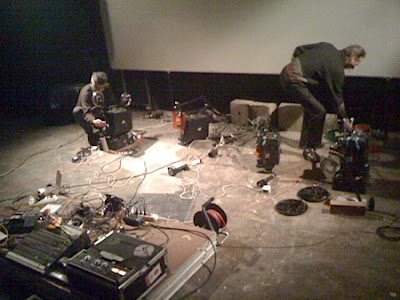 |
| Oosterlynck's 'Double écout'e' - Opus 166 2003 |
Piano wires across a room, salt on a grate, speaker tweeters and black pigment. Three works fill one room at the South London Gallery for
At The Moment of Being Heard. Aside from that one room, Baudouin Oosterlynck's own role in this ambitious exhibition might be to remind us
that innovation in sound is not new, nor is it dead-pan serious and ensconced in the realm of the well-presented, well-schooled artist. It is as quirky as any avant-garde art form has ever been, and thus as anarchic. Oosterlynck
released his first vinyl of musique concrète and poetry in 1978, yet
many people new to art think sound art began as a discipline when Susan Philipsz was the first
person ever to win the Turner Prize for sound works (The Turner was once considered the
Oscars of the art world). Yet what of Philipsz's predecessors, and the
culture of sound she came from?
 |
| crys cole. Salt, mirrored by another grate playing sounds of salt being poured |
 |
| Metamkine's set-up, before projectors are switched on |
 |
| Konrad Smoleński "Everything Was Forever, Until It Was No More" |
The reason
At The Moment of Being Heard is one of the best sound art shows we've seen yet is down to how the curators have considered the space. The notion of sounds sharing an open space is every curator's conundrum - will the sounds clash, or drown each other out, will it be too much for visitors...and so on. Too often curators opt for headphones, or one sound installation per room, Calvert 22 being one of many over-employing headphones. At The South London Gallery however, a dialogue is created between the sound works in open space, where they not only avoid clashing but share the air time, creating an additional, new piece out of their interaction with one another.
People often ask 'What's the difference between a sound sculpture and an installation?' The best answer I've been able to give is that an installation interacts with the space and is site-specific, whereas a sculpture can be moved from spot to spot and will remain the same. It is mobile in intent, if you will.
South London Gallery, while ambitious, are subdued with this show - there's no trumpet playing at the entrance, no press release claiming to have shaped our artistic landscape. Yet the exciting live program that runs throughout the show includes some of the most bombastic sound artists of our time, including French film and sound projectionist collective Metamkine who burnt film live in the performance and used the film
 |
| Pae White "Too much night, again" |
projectors, and indeed an amped up piano wire, to create the most compelling, if sometimes ear-splitting live sounds to match their live visuals. For those who go to South London Gallery more than twice a year
At the Moment of Being Heard will remind them of the installation before this one, because it is echoed by Keszler’s piano strings strung from wall to wall. Pae White filled South London Gallery with coloured yarn which spanned and criss-crossed the room creating supergraphics and a mesh to walk beneath. There's also resonances with Konrad Smoleński's unforgettable piece at the Polish Pavilion in the 2013 Venice Biennial "
Everything Was Forever, Until It Was No More". The sounds sculptures are similarly integrated into the architecture of the space, and your attention passes from object to object much as it does in SLG. However in Venice, massive church bells are set face to face across the room, close to floor and swing slowly into action, their is echo picked up by microphones and fed through two walls of massive speakers behind the bells, which boom out the processed sound once the bells have quit swinging, this sound in turn set off a wall of empty lockers behind each wall of speakers. The transition of the original sound of the bells speaks of classicism, of original thought, which modernity can only echo and rattle at. The acoustic signal appears to move the molecules of both animate and inanimate objects with equal force, just as the contrasting salt of crys cole lies across a grate and the black pigment of Rolf Julius on speaker tweeters are tested by the "real time" sound of Eli Keszler’s mechanical beaters hitting the piano wire strung across the room and ringing out in the space.
Sound is not just something you hear, it's a tool that exacts physical
effects on its surroundings and shapes a space. This show wants you to
remember that.





